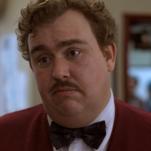Trump Dumped the Oreo for this #MadeinAmerica Cookie, the Hydrox
The story of a cookie that capitalized on Trump

A cursory Google of “sandwich cookie history” yields, mostly, Oreos. Consider the sandwich cookie (two wafers hugging a soft filling), though, and there’s seemingly little else beyond the Oreo. Since their invention in 1912, they’ve become the United States’ best-selling cookie, as popular abroad as they are at home and so good as to warrant all sorts of forgiveness (there’s absolutely no good reason for the existence of Limeade or Watermelon Oreos). The giant cookie emblazoned on the packaging soars like Superman, swathed by milk shaped like two hands flourishing a fallen-and-revived hero. As adhesive to the memory as their crumbs are to the molars, there is no sound more American than the crinkly opening of that package.
When Donald Trump announced last year that he’d never again eat Oreos, it felt like another display of his brand of thumb-sucking rebellion, the brattiness children use to assert an independence they don’t really have. The woman-grabbing, Taki-colored human Ear of Rice Emoji discovered that Mondelez International, manufacturer of Oreos through its Nabisco division, had closed a Chicago plant and was moving the facility to Mexico — Mexico, that propagator of rapists and brown boogeymen. At a Las Vegas rally, Trump had supporters chanting “NO MORE OREOS,” before wistfully adding, “Ah, it’s gonna be tough getting off Oreos.”

An ad by Unions 4 Workers
Yeah, right. In purporting Oreos to be somehow un-American, Trump accidentally became an image of anti-“Americanness” itself — you don’t get to personally boycott something so (deliciously) part of the American snack mythology without consequences. Stephen Colbert riffed on it, literally emptying a box of Oreos into his mouth. “Trump’s anti-Oreo stance puts other Republicans in a tough spot,” he said. “He’s forcing them to decide between alienating Latino voters and eating a Hydrox.” (Then he dry-heaved.)

Earlier this year, it was revealed that Trump may have first discovered the move after Ellia Kassoff, CEO of Leaf Brands, the manufacturer of Hydrox cookies, tweeted at him: “We’re making our @hydroxcookie in US, not like @Oreo moving to Mexico.” BURN! Other commenters started making memes surrounding the controversy.

An ad by Political Correctness Gone Wild
But there’s some truth to the idea that Hydrox cookies are distinctly American: they came first and are arguably just as good as Oreos. In 1908, Sunshine Biscuits debuted Hydrox, whose name implied purity (hydrogen, the simplicity of atoms). Though they consisted of a white crème filling between two chocolate wafers, they were less sweet than Oreos and far less popular. Later, Keebler purchased Sunshine, changed the cookies’ name to Droxies (which sounds like something that requires a prescription) and upped the sugar content. After Kellogg’s acquired Keebler, they removed Droxies from the market, much to the dismay of loyal fans.

-

-

-

-

-

-

-

-

-

-

-

-

-

-

-

-

-

-

-

-

-

-

-

-

-

-

-

-

-

-

-

-

-

-

-

-

-

-

-

-











































